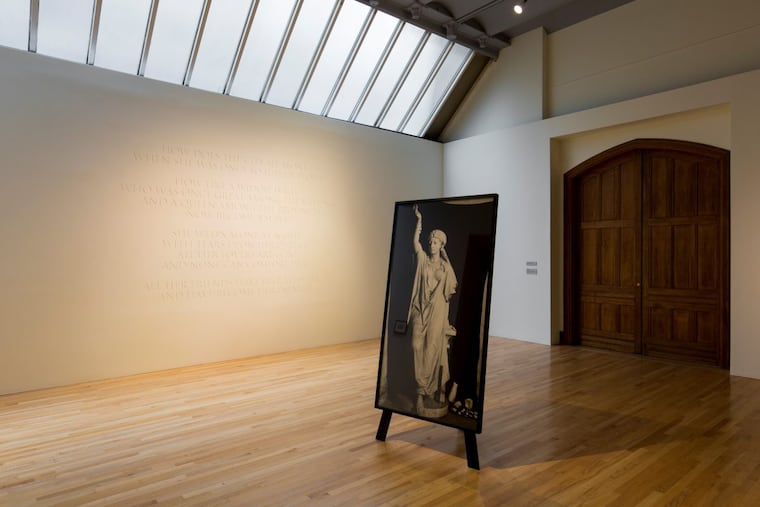Show at PAFA ponders the fate of two spurned statues
Also in Philly galleries right now: a breezy pop-art group show and Tiger Strikes Asteroid's housewarming show at Crane Arts.

During a semester-long artist's residency at the Pennsylvania Academy of the Fine Arts that coincided with the 2016 presidential election, Philadelphia artist Leah Modigliani (a distant relative of the modernist master Amedeo) made a discovery that became central to an exhibition she was planning for the academy's Morris Gallery.
While doing research for her project at PAFA's Center for the Study of the American Artist, Modigliani came across two aged registrar's index cards revealing the fates of two donated neoclassical marble sculptures of female figures that were unveiled at the 1876 opening of PAFA's Historic Landmark Building.
Tastes changed, of course.
Jerusalem in Her Desolation, by William Wetmore Story, was de-accessioned in 1949 and moved to a park in Frazer, Chester County, then reacquired in 1986 by PAFA, where it can be seen today. Deborah, by Giovanni Battista Lombardi, wasn't so lucky. Defaced by a disgruntled PAFA employee in 1937 and later restored, it was destroyed by the museum in 1950 after it failed to sell.
The sculptures' histories of being admired and then cast away left an impression on Modigliani, whose faith in a democratic society was feeling challenged.
Those two typed cards with their carefully handwritten updates were photographed for Modigliani's exhibition and are now framed archival pigment prints, hung side by side in the Morris Gallery. They're a small but not insignificant part of Modigliani's "The City in Her Desolation," an installation that compares the fates of the two female sculptures with our current political (and geopolitical) instability and the accelerated destruction of cities and ancient monuments through acts of war.
Modigliani kept her installation minimal and has made the most of this skylighted space's chapellike architecture.
A long, wall-mounted shelf displays the show's namesake, The City in Her Desolation, a diminutive accordion-style book of black-and-white photos of cities reduced to rubble (Modigliani found these images on the web and altered them). Though we've seen photographs like these in newspapers, and reproduced at a larger scale, this particular barrage of horrific destructions is mind-numbing in its thoroughness.
A new archival pigment print made from a photograph of Jerusalem in Her Desolation in PAFA's collection files shows the sculpture in the Frazer park before PAFA reacquired it, looking especially mournful with its backdrop of cypress trees.
A nearly life-size archival pigment print from a photograph of the damaged Deborah, found in PAFA's Woodcock Archives, is mounted in a freestanding frame shaped like a mirror, making the image of the sculpture appear to be a reflection and even more human.
The installation's one monumental work, of fiberboard panels painted the color of tan sandstone and carved with a passage from The Book of Lamentations (the same passage inscribed on the right side of Story's sculpture), might initially be considered the quietest and most poetic of these introspective works, fading gently into the background like a palimpsest of an ancient edifice. But its ersatz stone captures the current fake-news era uncannily.
Through Aug. 23 at the Pennsylvania Academy of the Fine Arts' Morris Gallery, 118-128 N. Broad St., 10 a.m. to 5 p.m. Tuesday through Friday, 11 a.m. to 5 p.m. Saturday and Sunday. Tickets $15; seniors and students $12; youth (13 to 18 years) $8; children under 13 free. Information: 215-972-7600 or pafa.org.
Housewarming for Tiger Strikes Asteroid at Crane Arts
Painter Jane Irish, Tiger Strikes Asteroid artist Mary Henderson, and philosopher and writer Crispin Sartwell have organized the TSA art collective's first exhibition at its new quarters in the Crane Arts Building. A group show, "Anachronism and Liberation," with works by Ana Hernandez, Robert Lugo, Rebecca Ness, Odili Odita, Robert Pruitt, Lisi Raskin, Han Wang, Charles Edward Williams, and Alexi Worth argues that artworks in traditional mediums, such as painting and porcelain, can express politicized identities with the best of them (we knew that, but an abstract painting by Nigerian-born Odita contains codes one might not necessarily recognize in its compositions of vividly colored, spiked geometric forms).
Charles Edward Williams' nocturnal painting featuring a disembodied hand at first registers as a creepy dark scene by way of David Lynch. It's that and much more and worse: the image is Williams' version of Eric Garner's death by police asphyxiation.
Roberto Lugo's elegant painted and lustered porcelain teapot incorporates dirt from his neighborhood and features a portrait of the African American statesman and abolitionist Frederick Douglass front and center. It expresses Lugo's personal history growing up in North Philadelphia but also challenges the privileged class who demanded such luxury items and supported their manufacture by underpaid workers.
Through Sept. 14 at Tiger Strikes Asteroid, 1400 N. American St., noon to 4 p.m. Fridays, 2 to 6 p.m. Saturdays, 6 to 9 p.m. second Fridays, and by appointment. www.tigerstrikesasteroid.com.
Pop-art fun for hot times
The summery, pop-art-inflected group show "See-Through" at James Oliver Gallery through Sunday looks terrific in the venue's all-white, fourth-floor aerie.
Philadelphia painter Tim McFarlane's latest abstract paintings are smaller than usual and depict more condensed gestures. Wendee Yudis' copies of vintage advertisements photo-silkscreened on walnut trunk sections and wood panels merge a '60s pop aesthetic with the rustic DIY one of the aughts.
Michael Barker, British and a former art director who worked in London, New York, and elsewhere, offers memorably composed color photographs of the architectural splendors of Wildwood.
Others in the group show: paintings in automotive paint by Mark Basco, and a clear acrylic chair by James Crowell.
The gallery has extended the show one day to accommodate those who read this column in the Sunday Inquirer or online at philly.com. The gallery, usually open only by appointment on Sundays, will be open from 1 to 6 p.m.
James Oliver Gallery, 723 Chestnut St, 4th floor, 5 to 8 p.m. Wednesdays through Fridays, noon to 8 p.m. Saturdays, Sundays by appointment. Information: 267-918-7432 or jamesolivergallery.com.